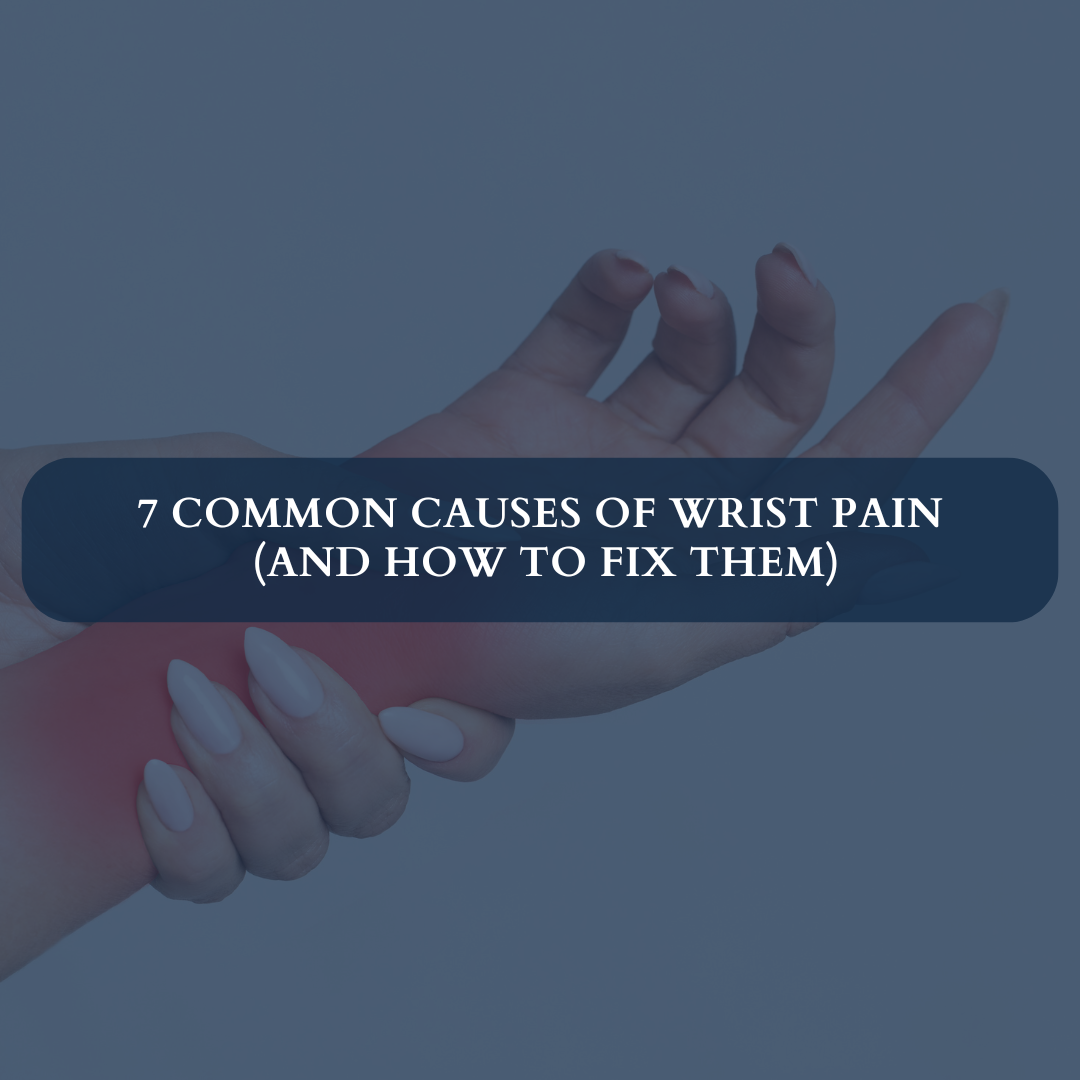Are you experiencing nagging wrist pain that just won’t seem to go away? You’re not alone. Wrist pain can be a frustrating and debilitating issue that affects people of all ages and walks of life. In this comprehensive guide, we’ll explore seven common causes of wrist pain that you might not be aware of, as well as effective strategies for relieving and preventing it.
1. Carpal Tunnel Syndrome: The Silent Agony
One of the most prevalent causes of wrist pain is carpal tunnel syndrome (CTS). This condition occurs when the median nerve, which runs from your forearm into your hand, becomes compressed or irritated. Typing, repetitive hand movements, and certain medical conditions like diabetes can contribute to the development of CTS. Symptoms include numbness, tingling, and weakness in the hand and wrist. Treatment options range from wrist splints and ergonomic adjustments to surgery in severe cases.
How to fix:
For mild to moderate cases of carpal tunnel syndrome, conservative treatments such as wearing a wrist splint, taking frequent breaks from repetitive tasks, and practicing ergonomic techniques can provide relief. Additionally, incorporating wrist stretches and exercises into your daily routine can help improve flexibility and reduce pressure on the median nerve. In more severe cases, your healthcare provider may recommend corticosteroid injections or surgery to relieve pressure on the nerve.
2. Repetitive Strain Injury (RSI): The Office Worker’s Plight
For those glued to their desks for hours on end, repetitive strain injury (RSI) is a familiar foe. RSI encompasses a range of musculoskeletal disorders caused by repetitive movements, forceful exertions, or awkward postures. Typing, clicking a mouse, or even holding a phone can strain the muscles and tendons in the wrist, leading to pain and discomfort. Taking regular breaks, practicing proper ergonomics, and performing wrist exercises can help alleviate RSI symptoms.
How to fix:
To combat RSI, it’s essential to take regular breaks from repetitive tasks and vary your hand and wrist movements throughout the day. Implementing ergonomic adjustments to your workspace, such as using a supportive chair and positioning your keyboard and mouse at the proper height, can also help alleviate strain. Additionally, performing wrist and hand exercises, such as wrist circles and finger stretches, can strengthen the muscles and tendons and improve overall flexibility.
3. De Quervain’s Tenosynovitis: The Thumb Woes
De Quervain’s tenosynovitis is a painful condition that affects the tendons on the thumb side of the wrist. It typically arises from overuse or repetitive thumb movements, such as lifting, gripping, or wringing activities. Individuals with this condition often experience swelling, tenderness, and difficulty gripping objects. Treatment may involve rest, splinting, anti-inflammatory medications, and physical therapy to improve thumb mobility and strength.
How to fix:
Treatment for De Quervain’s tenosynovitis often begins with rest and immobilization of the thumb and wrist using a splint. Avoiding activities that exacerbate symptoms, such as repetitive thumb movements, can help reduce inflammation and promote healing. Nonsteroidal anti-inflammatory drugs (NSAIDs) may be prescribed to alleviate pain and swelling. Physical therapy exercises focused on stretching and strengthening the thumb and wrist muscles can also aid in recovery.
4. Wrist Sprains and Strains: The Unforeseen Accidents
Accidents happen, and sometimes they result in wrist sprains or strains. Whether from a sports injury, a fall, or a sudden twist, the ligaments and muscles in the wrist can become stretched or torn, leading to pain, swelling, and limited range of motion. Rest, ice, compression, and elevation (RICE) are initial treatments for acute wrist injuries. Physical therapy and gradual rehabilitation exercises may be necessary for complete recovery.
How to fix:
Following the RICE protocol (rest, ice, compression, and elevation) in the immediate aftermath of a wrist sprain or strain can help reduce pain and swelling. Once the acute phase has passed, gentle range-of-motion exercises can be gradually introduced to restore flexibility and strength to the affected wrist. Depending on the severity of the injury, a physical therapist may prescribe specific exercises to target the injured ligaments and muscles and facilitate healing.
5. Arthritis: The Silent Invader
Arthritis, a degenerative joint disease, can affect any joint in the body, including the wrist. Osteoarthritis, rheumatoid arthritis, and gout are among the most common types of arthritis that can cause wrist pain. Symptoms include joint stiffness, swelling, and decreased range of motion. While there is no cure for arthritis, treatments like medication, splinting, joint injections, and lifestyle modifications can help manage pain and improve function.
How to fix:
Managing arthritis-related wrist pain often involves a combination of medication, joint protection techniques, and lifestyle modifications. Nonsteroidal anti-inflammatory drugs (NSAIDs) can help alleviate pain and reduce inflammation. Wearing a wrist splint or brace can provide support and stability to arthritic joints, particularly during activities that exacerbate symptoms. Engaging in low-impact exercises such as swimming or cycling can help maintain joint mobility and strengthen surrounding muscles without placing undue stress on the wrist.
6. Ganglion Cysts: The Mysterious Bumps
Ganglion cysts are benign, fluid-filled sacs that often develop on the wrist or hand joints. While their exact cause is unknown, they may form due to joint or tendon irritation. These cysts can vary in size and may or may not cause symptoms. When symptomatic, they can cause pain, weakness, and discomfort with wrist movement. Treatment options range from watchful waiting to aspiration or surgical removal for persistent or bothersome cysts.
How to fix:
Small, asymptomatic ganglion cysts may not require treatment and may resolve on their own over time. However, if a cyst is causing pain or interfering with wrist function, aspiration (draining the fluid with a needle) or surgical removal may be recommended. Following aspiration or surgery, immobilization of the wrist with a splint or brace may be necessary to facilitate healing. Physical therapy exercises focused on restoring range of motion and strength can aid in rehabilitation.
7. Fractures: The Bone Breakers
Last but not least, wrist pain can stem from fractures or broken bones. Whether from a fall onto an outstretched hand or a direct blow to the wrist, fractures can cause intense pain, swelling, bruising, and deformity. Seeking prompt medical attention is crucial for proper diagnosis and treatment. Depending on the severity and location of the fracture, treatment may involve immobilization with a cast or splint, physical therapy, or surgical intervention.
How to fix:
Treatment for wrist fractures depends on the severity and location of the injury. In cases of minor fractures, immobilization with a cast or splint may be sufficient for healing. More complex fractures may require surgical intervention to realign the bones and stabilize the joint. Following treatment, physical therapy exercises aimed at improving range of motion, strength, and proprioception can help restore function to the injured wrist.
Also Read
Physiotherapy – 5 Ways It Can Help Post Fracture!
In conclusion, wrist pain can stem from a variety of causes, ranging from overuse and repetitive strain to traumatic injuries and underlying medical conditions. By understanding the potential culprits behind your wrist pain and implementing appropriate preventive measures and treatment strategies, you can effectively manage your symptoms and regain function in your wrist. Remember to listen to your body, prioritize rest and self-care, and consult with a healthcare professional if your wrist pain persists or worsens. Don’t let wrist pain hold you back from living your life to the fullest!
Ready to explore your options for chiropractic and physiotherapy? Contact SwastyaPhysio today to schedule a consultation and discover the best path to your wellness journey. We’re here to support your health every step of the way.
Banaswadi | HBR layout | Kalyan Nagar | Kammanahalli | Horamavu | Hennur






